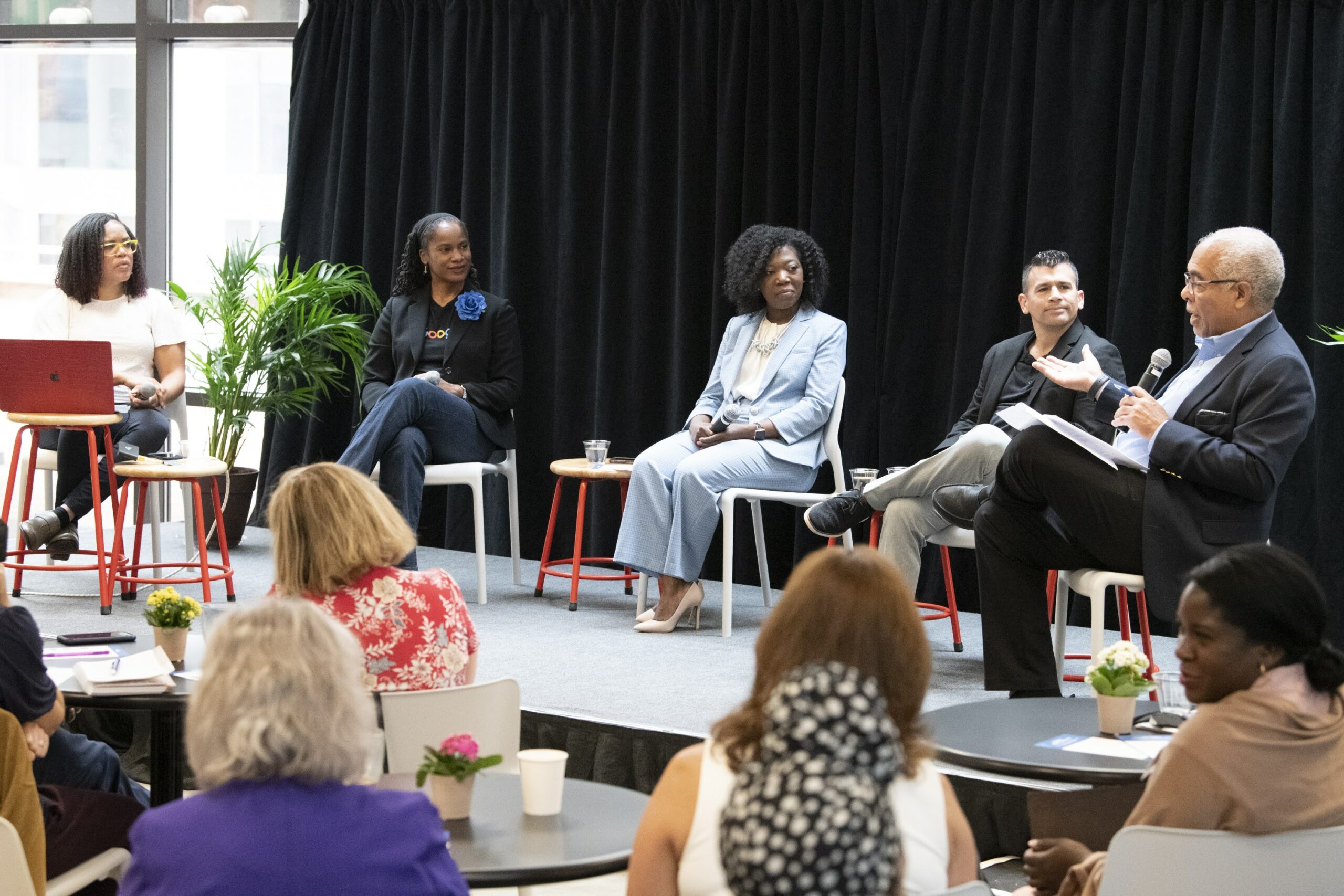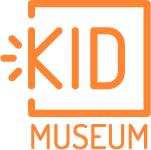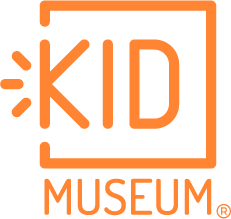IN CONVERSATION
Leaders in education and equity discuss how we can dismantle disparities in STEM & promote inclusive learning environments
KID Museum is transforming what and how kids learn. With a focus on equity and social justice, we are creating space for all kids to unlock their creative potential to become the innovators and changemakers of the future.
As we emerge from the pandemic, we face a watershed moment to remake learning to help youth get back on track, and fundamentally rethink how we foster more equitable student outcomes to advance greater diversity in our region’s STEM talent pipeline.
In May, we convened experts in the field of equity and education to take on this pressing issue. Following are key take-aways from our lively symposium and community conversation.

Special Guest: Dr. Ebony McGee
Professor of Education, Diversity and STEM Education at Vanderbilt University
Dr. Shanika Hope
Director of Computer Science Education at Google
Dr. Monifa McKnight
Superintendent of Montgomery County Public Schools
Dr. Rudy Ruiz
Founder & CEO of Edifying Teachers; VP & Partner at FourPoint Education Partners
Byron Johns (Facilitator)
Chair, Montgomery County NAACP Parent Council
Hosted by KID Museum & The Children’s Opportunity Fund
Disparities in STEM & Why it Matters
Throughout the 1970’s, 80’s, and 90’s, there was a steady increase in Black and Brown scientists and engineers. But for the past 20 years, we’ve gone backwards, with fewer nonwhite youth pursuing STEM careers, even as demand for workers in these fields grows at a rapid pace.
STEM careers offer competitive salaries, and so the disparity in STEM perpetuates income inequalities, even as it hinders economic growth for society as a whole. It also hinders innovation, which depends upon different perspectives and experiences to thrive. Without the contributions of people from different backgrounds and income levels (people whom Raj Chetty calls the “lost Einsteins”), we all lose.
If we are going to disrupt the system and make necessary change, we must first understand the structure and culture of STEM, and what nonwhite students face in order to succeed in this arena. Dr. Ebony McGee presented her research on this subject to a packed room at KID Museum. It resonated deeply. Person after person — Black STEM professionals from both our panel and the audience — stood up to say that she was describing their lived experience too.
So how can we start to dismantle disparities in STEM and build more inclusive learning environments? Dr. McGee and our distinguished panel of experts discussed concrete steps we can take.
Don’t ask what do you want to be, but what problem do you want to solve?
- Dr. Ruiz
Industry can stand with nonprofits by pushing policy — creating STEM opportunities for all.
- Dr. Hope
More Than a Leaky Pipeline
Dr. McGee’s research delves into the structural hurdles Black and Brown students face in STEM. Herself a former engineer, Dr. McGee uncovers the toxic culture of STEM, from which an astounding 61 – 67% of Black and Brown students are “leaking out” of the pipeline: “If a plumber came to your house and saw 67% of the water leaking out of the pipes, they wouldn’t say we should patch those pipes — they would say the pipes are broken and need to be taken out.”
Black and Brown students must navigate:
LACK OF RESOURCES
Black and Brown STEM students must operate in a structure that was not designed for them — and is often hostile and alienating. They face roadblocks on multiple levels: lack of AP classes — and lack of access when they are offered, lack of college counseling, lack of role models, and a lack of resources. Dr. McGee developed a water park model analogy, with two different tracks for white and nonwhite families, illustrating the extra hurdles nonwhite students face all along the way, beginning from birth.
IMPOSTER SYNDROME
Minoritized students who excel at STEM are often made to feel like “imposters,” as well as the pressure of being a “model minority.” This produces an enormous amount of stress, resulting in physical and mental health strains. Students are often told that these feelings are all in their head, but as Dr. McGee explains it, “you can’t yoga pose your way out of a toxic environment.”
LACK OF BLACK TEACHERS
Public school systems are becoming more diverse — 54% of public school students are nonwhite — but students don’t see teachers who look like them in the classroom. The number of Black teachers has been declining over the years. In Maryland, 1 in 5 schools have no Black teachers at all, and nearly half of Maryland schools have no Latinx teachers. Students need to see someone they can identify with; they need role models.
FRAGILE STEM IDENTITY
Black and Brown students in STEM often have to defend why they are there and navigate implicit bias, maintaining a fragile identity within a sometimes hostile environment. Black, white and Latinx students declare STEM majors at roughly the same rates, but two-thirds of Black and Latinx students leave these majors before they graduate. According to data from the National Science Foundation, Black graduates with degrees in engineering and math declined from 2001 to 2016. “Imagine a world where they could just love the math,” says Dr. McGee. “And not have to always prove that they should be there.”
Key Recommendations from Our Panel
WHAT SCHOOLS CAN DO
“We have to start STEM exposure earlier, before middle school. And what they do at KID Museum has to exist in the classroom too.” – Dr. Monifa McKnight
- Provide early and consistent exposure to STEM in elementary school, giving kids a sense of belonging and cementing interest and confidence in STEM.
- Develop co-curricular solutions that purposefully focus on closing the equity gap during the school day, not just as an enrichment opportunity.
- Work with teachers and administrators to create supportive pathways for students.
- Support teachers and administrators to create more stability and retention.
- Invest in teachers: provide externships and professional development for teachers to build their skills and knowledge.
- Empower teachers as changemakers.
KIDS AS CHANGEMAKERS
“Don’t ask what do you want to be, but what problem do you want to solve?” – Dr. Rudy Ruiz
When Black and Brown students are asked what they want to do in STEM, they have a great desire to integrate STEM with social and racial justice. Dr. McGee’s research found that they want to combine STEM skills with their own experiences to make the world a better place. STEM instruction needs to focus on what motivates minoritized students, and empower them to see themselves as changemakers.
VALUE ON FAMILIES
“We have to place value on our families. Parents are always teaching. Schools need to build connections with parents, to get them more engaged and feeling valued.” – Dr. Monifa McKnight
We tend to downplay the role of non-STEM support systems, but often a child’s first math teacher is their mother or father. There is STEM happening naturally at home — some of our participants talked about learning math from their mother’s card games, or learning STEM skills from working with their dad to rebuild a broken Casio keyboard that he salvaged and brought home for her.
ROLE OF TEACHERS
“Rather than put our best teachers in AP and Honors, they should instead be placed with the students with the greatest needs. We all win when all of our students win.” – Dr. Shanika Hope
Teachers are crucial to student success — in fact, they are the number one factor in determining that success. We must invest in our teachers. We need to actively recruit and retain educators of color, providing resources, professional development, and support. We also need to, as stated by Dr. Hope: “reset our mindset of where we place our best teachers.” The best teachers should be teaching students with the greatest needs.
UNDERSTANDING STUDENT NEEDS
“Are we doing the work with schools about how they make determinations of who gets what classes?” – Dr. Monifa McKnight
Schools should incorporate positive, culturally affirming experiences into K-12 learning, so that kids build a sense of belonging and identity. School administration, in collaboration with teachers, can create supportive pathways for students, including access to rigorous coursework, learning opportunities, and mentors, while remaining accountable for how they are supporting — or impeding — student success.
OUT-OF-SCHOOL-TIME ENRICHMENT
“It’s important to integrate out-of-school-time opportunities for kids, especially ones that target students in need.” – Dr. Rudy Ruiz
Students should have consistent exposure to hands-on learning opportunities that help them build confidence and interest in STEM, beginning in the earliest grades. These learning experiences should be incorporated into classroom curriculum and designed with equity in mind, empowering kids to make their own mark on the world.
LEVERAGE THE COMMUNITY
“Blurring the line between schools and communities, industries can provide mentorship, giving opportunities for kids to actually apply the math they are learning. Industry can stand with nonprofits by pushing policy — creating STEM opportunities for all.” – Dr. Shanika Hope
Schools can play a role in not only preparing students for STEM fields, but preparing the STEM industry for Black and Brown students, and in particular, what it will take to keep them there. Schools and the STEM community can partner to provide students with real-life STEM experiences. Equally important are the role models and mentorship opportunities that partnerships like this provide.

